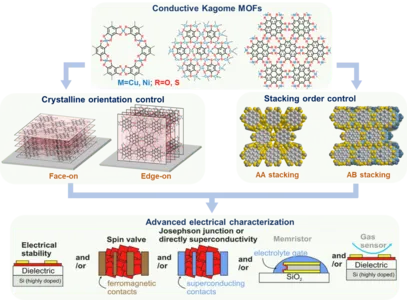Layer-orientated 2D Conjugated Metal-Organic Framework Films toward Directional Charge Transport
2D conjugated metal-organic framework • layer orientation control • semiconductor
Zhiyong Wang,[a] Lisa S. Walter,[b] Jianjun Zhang,[a] Lukas Renn,[b] Jonas Pöhls,[c] R. Thomas Weitz,[b,c] and Renhao Dong[a]
(a) Center for Advancing Electronics Dresden (cfaed) and Faculty of Chemistry and Food Chemistry Technische Universität Dresden, 01062 Dresden, Germany
(b) Physics of Nanosystems, Department of Physics, Ludwig-Maximilians-University München, 80799 Munich, Germany
(c) I. Physical Institute, Faculty of Physics Georg-August-University Göttingen, 37077 Göttingen, Germany
Layered two-dimensional conjugated metal-organic frameworks (2D c-MOFs) have been emerging as (semi-)conductors for electronics, which generally exhibit anisotropic features in the bulk transport due to their charge transfer along both interlayer (π-π stacking) and intralayer (basal plane) pathways.[1-3] The development of layer-orientated 2D c-MOF films enables an access to direct the charge transport, dial-in lateral/vertical electronic devices and determine the intrinsic transport mechanism, but remains a significant synthetic challenge. Here we report the synthesis of edge-on layer-oriented p-type semiconducting 2D c-MOF films comprising phthalocyanine ligands (Cu2[PcM-O8], M=Cu or Fe) on the water surface. We figure out the crystal orientations of the 2D c-MOFs films with molecular precision and establish a correlation between ligands and their layer alignment. The improvement of π-π stacking between PcM ligands by M···π (N) interaction prefers for an edge-on configuration, while the hydrogen bonding between metal-free ligands and water molecule dominates a face-on assembly. Macroscopic (cm2-size) and local (sub-µm) charge transport measurements on Cu2[PcCu-O8] film, combined by theoretical calculation, suggest that the intrinsic conductivity is dominated by the interlayer charge transfer. Typically, charge mobilities along the interlayer and intralayer pathways can reach ~4.4 cm2 V-1 s-1 and ~0.36 cm2 V-1 s-1, respectively; the interlayer conductivity of ~2×10-3 S cm-1 is 100-fold higher than the intralayer one. These findings open up an avenue for the controlled synthesis of layer-oriented semiconducting 2D c-MOF films toward directional charge transport and electronic device integration as well as the reliable elucidation of the transport mechanism.
References
(1) Dong, R. et al. A coronene-based semiconducting two-dimensional metal-organic framework with ferromagnetic behavior. Nat. Commun. 2018, 9, 2637.
(2) Dong, R. et al. High-mobility band-like charge transport in a semiconducting two-dimensional metal-organic framework. Nat. Mater. 2018, 17, 1027-1032.
(3) Yang, C. et al. A semiconducting layered metal-organic framework magnet. Nat. Commun. 2019, 10, 3260.
Interested in finding out more? Click here to learn more about this overarching COORNETs Phase II team and project.
